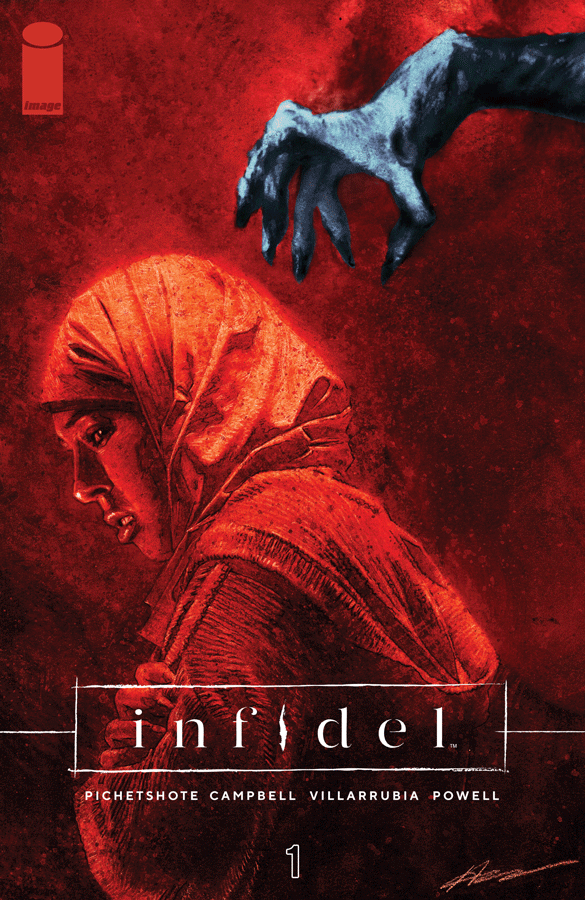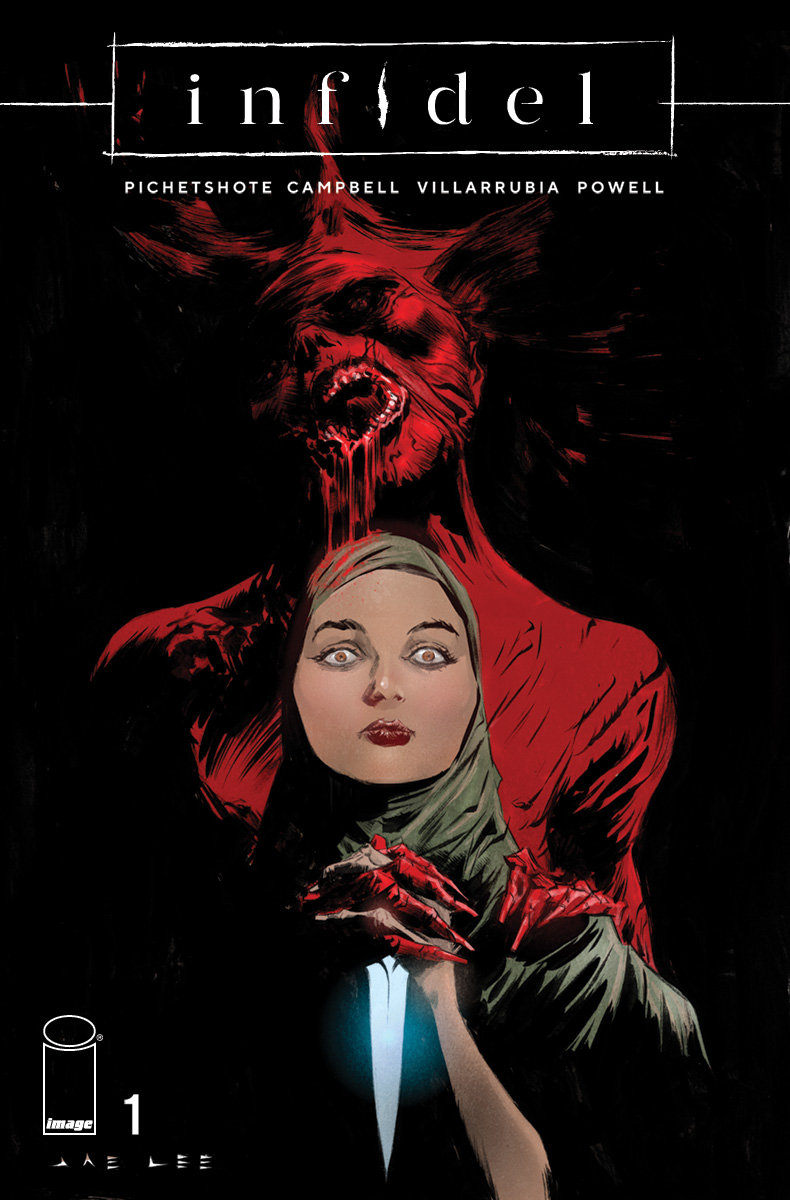Infidel #1
Posted on March 17, 2018 by John Elrod II in Infidel // 0 Comments
What do you get when you take the classic horror trope of a haunted house and cross it with social consciousness? When you introduce literal demons to the figurative ones plaguing society? You get a mixture of scares that feels fresh in its ability to infuse fears familiar to the horror genre with feelings often overlooked. You get a story that acknowledges the actual phobia in xenophobia and Islamophobia. You get Infidel.
The story of Infidel, as we know it so far, would appear to be fairly straightforward for the horror genre: a family recently moved into a building where something tragic happened, and-whoops-now it’s haunted by some kind of entities. I guess we can all go home, right? We’ve seen this before; we know how it goes. But wait, there’s more because of course there is. The family is made up of Aisha, Tom, and Kris (Tom’s daughter from a previous relationship). Aisha is a Muslim, and Tom is not; that is forced to matter because Tom’s mother, Leslie, is Islamophobic, and they have moved in with her. Oh, and Aisha’s mother is not too accepting, either.
What does this have to do with horror? What happened to the entities haunting the building?
As it turns out, the entities are bigots, too. Who knew? It’s not that simple, of course; there are layers to why the entities behave the way they do (and, I’d guess, why they target who they target), and that-at least after a single issue-is the beauty of this series.
Use of the horror genre of storytelling to reflect our most intimate feelings is certainly nothing new. From Strange Case of Dr. Jekyll and Mr. Hyde‘s examination of contemporary classism in London, to the multiple social commentaries made by The Twilight Zone, to the several possible statements on love and sex made by It Follows, to everything about every episode of Black Mirror: horror in storytelling has a unique opportunity to connect with a reader or viewer on a visceral level.
In 2017, two major films were able to use the horror genre as a vehicle for examining the lived experiences of persecuted people in modern America: Jordan Peele’s Get Out and Guillermo del Toro’s The Shape of Water. Get Out turns a mirror on “post-racial” America to reflect the kind of liberal ignorance that leads to something like white feminism. The Shape of Water, instead, turned its mirror on the past and, in doing so, was able to reflect back issues of othering and xenophobia that still exist today.
At least, that’s what you get on the surface of those two films. Sometimes a cause can be so blindingly obvious you don’t see its effect. The horror of Get Out is not liberal ignorance, just as the horror of The Shape of Water is not othering; the horror is in living it. The fear is not in those who are xenophobic but in those who are seen as different.
Infidel follows in these same footsteps with its use of conventional horror tropes in an attempt to show the horror of living through Islamophobia. Aisha lives in a building haunted by bigotry and prejudice, and that building is called the United States of America.
I spent a lot of inches talking about the story, I know, but that’s because writer Pornsak Pichetshote has done such a good job on his debut comic script. Don’t worry, though, I’m going to ramble about the art, too.
Do you remember Aircel Comics? You’d be forgiven if not. Truthfully, I don’t fully remember them; they were a Canadian comic book publisher in the late-’80s/early-’90s whose biggest title was Men in Black (yes, that MIB). The reason I bring them up here is because my brother used to read some Aircel titles when we were kids. Well, he’s ten years older than I am, so I was a kid; he was a teenager. What I remember most about them are the covers, particularly a series titled Nocturne. I feel such a weirdly nostalgic horror just thinking about how I felt seeing those covers; I don’t believe I’ve ever even read an issue, even though I’m pretty sure I still own at least one.
The reason I said all of that is because every page-every panel-of this issue took me back to how scared, yet intrigued, I was by those comics and the “for mature readers only” disclaimer on the cover. Now, I don’t often read horror comics, so I’m sure the way Aaron Campbell and José Villarrubia illustrate Infidel probably reminds other readers of things that weren’t published by a defunct company 25 years ago (they’re probably more likely to think of things from Vertigo, of which Pornsak Pichetshote used to be the editor), but for me? All I see when I turn these pages of shadows messily spilling from panel-to-panel is Nocturne, and it scares me. All of this scares me. All of it.
The back matter here is scant, but what we do get is a very well-written letter from Pichetshote discussing why he wanted to write Infidel and introducing the creative team behind the series, which includes the aforementioned Campbell and Villarrubia, as well as the series’ letterer and designer Jeff Powell. The plan seems to be to include a letters section each month, as long as they receive letters, so we should be able to expect some good back matter for the remainder of this 5-issue miniseries’ run.
Infidel #1 Review Score
-
Plot – 9.5/109.5/10
-
Dialogue – 9/109/10
-
Art – 9/109/10
-
Cover – 10/1010/10
-
Back Matter (Letters section, additional material, etc.) – 9/109/10
Infidel #1 (of 5)
Writer: Pornsak Pichetshote | Artist: Aaron Campbell | Colorist & Editor: José Villarrubia | Letterer & Designer: Jeff Powell | Cover A: Aaron Campbell & José Villarrubia | Cover B: Jae Lee & José Villarrubia | Publisher: Image Comics





